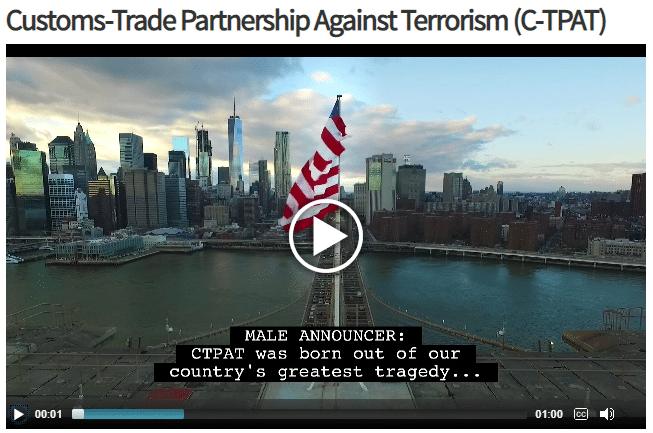Minimum Security Criteria in CTPAT
CTPAT’s First Revision of Security Criteria
U.S. Customs and Border Protection is currently undergoing draft modifications to the minimum security criteria (MSC) associated with Customs Trade Partnership Against Terrorism. CBP is gathering input on the proposed changes through the end of October and plans to implement the final updated MSC under a phased approached throughout fiscal year 2019. [Source]
According to Sandler, Travis and Rosenberg, international trade experts, “CBP states that this is the first major revision of the MSC since the inception of CTPAT and is designed to modernize and strengthen requirements to more effectively combat evolving supply chain security threats such as the exponential increase in the volume and complexity of trade, the heightened risk of data breaches and cyberattacks, and the continued targeting of global supply chains by terrorists and criminal organizations. Generally the changes include establishing three focus areas and three new criteria categories, explicitly delineating requirements as ‘must’ or ‘should’ based on risk, and providing guidance on how to combat terrorism financing and money laundering.”
What is CTPAT?
U.S. Customs and Border Protection (CBP) Customs-Trade Partnership Against Terrorism (CTPAT) offers businesses an opportunity to play an active role against terrorism and simultaneously manage a trade compliant global supply chain. By participating in this first worldwide supply chain security initiative, companies will ensure a more secure supply chain for their employees, suppliers and customers.
Benefits:
- good corporate citizenship
- A reduced number of inspections and reduced border wait times
- faster processing of Customs entries
- which means faster releases of merchandise
- shortened supply chain
- A CTPAT supply chain specialist to serve as the CBP liaison for validations, security issues, procedural updates, communication and training.
- Self-policing and self-monitoring of security activities.
- In the Automated Commercial System (ACS), CTPAT certified importers receive reduced selection rate for Compliance Measurement Examinations and exclusion from certain trade-related local and national criteria.
- CTPAT certified importers receive targeting benefits by receiving a “credit” via the CBP targeting system.
- Certified CTPAT importers are eligible for access to the FAST lanes on the Canadian and Mexican borders.
- CTPAT certified highway carriers, on the Canadian and Mexican borders, benefit from their access to the expedited cargo processing at designated FAST lanes. These carriers are eligible to receive more favorable mitigation relief from monetary penalties.
- CTPAT certified Mexican manufacturers benefit from their access to the expedited cargo processing at the designated FAST lanes.
In order to be accepted into the CTPAT program, a company must currently meet the following Minimum Security Criteria, which can also be found here. Click on the following genre that best describes your company to find out what current MSC is required. Current CTPAT members will not be expected to adhere to the new standards until early 2020.
Current Requirements
Exporters
Foreign Manufacturers
Importers
Proposed Changes
Sandler, Travis and Rosenberg put together the following chart that shows the updated MSC:
Focus area |
MSC categories |
Description |
Corporate security |
Security vision and responsibility (new) |
Promote a security vision, integrate security throughout the organization, establish an audit process, importance and role of the CTPAT point of contact |
Risk assessment |
Complete a comprehensive risk assessment based on a recognized methodology and in line with the MSC |
|
Business partner requirements |
Select, screen, and monitor business partner compliance with MSC, including trade-based money laundering |
|
Cybersecurity (new) |
Written cybersecurity policies and procedures, protection of IT systems with software and hardware, remote access, personal devices |
|
Transportation security |
Conveyance and IIT security |
Conduct thorough inspections for both security and visible agricultural contamination, driver verification, tracking of conveyances, random searches |
Seal security |
High security seal policy, containers not suitable for sealing, mandated use of the VVTT seal verification process, management audit of seals |
|
Procedural security |
Document processes relevant to transportation, handling and storage of cargo |
|
Agricultural security (new) |
Requirements that protect the supply chain from contaminants and pests and the proper use of wood packaging materials |
|
People and physical security |
Physical access controls |
Requirements to prevent, detect, or deter unauthorized personnel from gaining access to facilities; expands on the use of security technology |
Physical security |
Positive identification of all employees, visitors, and vendors at all points of entry |
|
Personnel security |
Complete screening, pre-employment verification, background checks, and comply with U.S. immigration laws |
|
Security training, threat, and awareness |
Training on security for all employees, specialized training for employees in sensitive positions, determine if training was effective |
For questions about CTPAT or you would like to know more about CTPAT Certification, Validation or Consulting, please contact consulting@scarbrough-intl.com.

